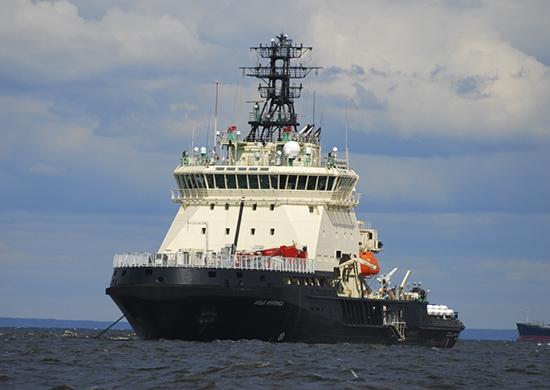Giant Icebreaker Soon Ready for Russia’s Northern Fleet

Two and a half years ago, St. Petersburg’s Admiralty Shipyards begun work on the first Russian military icebreaker in decades. Today, the advanced icebreaker “Ilya Muromets” is undergoing official tests - and early next month it will venture out on its journey to join to the Northern Fleet.
The Russian Navy’s state-of-the-art icebreaker designed for Arctic operations set off to begin official tests in the Baltic Sea last Thursday.
“The Navy has not accepted icebreakers into its structure for over 40 years already and, therefore, the construction of the “Ilya Muromets” icebreaker was a historic event for us”, Russian Navy Deputy Commander-in-Chief Alexander Fedotenkov said at the Admiralty Shipyard’s wharf when inspecting the vessel before the launch of the state trials.
A long-desired addition to the fleet
“We need the icebreaker very much, considering that Russia has returned to the Arctic and that battleships constantly voiage off to Arctic regions. With the arrival of the icebreaker for the Northern Fleet, the grouping in Arctic regions will be self-sufficient”, he added.
The work on the icebreaker, which is named after an epic hero of medieval Russian legends, begun in April, 2015. The icebreaker will soon be part of the Russian Navy’s Northern Fleet, where it – amongst others - will deploy troops and escort transport convoys to supply bases and airports within the Arctic region.
The Ilya Muromets, which can carry up to 6.000 tons, is expected to have a crew of 32, a sea endurance of 60 days and a cruising rate of 12,000 miles. She will be able to cut through ice up to one meter thick in order to provide safe passage for vessels sailing through the Arctic, and she can also tug smaller ships as well as perform an array of other support missions.
Propellor can be rotaded 360 degrees
The icebreaker has a propulsion system that allows the vessel to sail in any direction, including forward, backward and sideways, and it is furnished with everything from survey motorboats to a laboratory for hydrometeorological studies.
According to Russian Navy spokesman Igor Dygalo, the “Ilya Muromets” is the most advanced icebreaker built for the Russian Navy at the Admiralty Shipyard. It has been under construction on the same slipway that was once used to build the world’s first ever nuclear-powered icebreaker, the "Lenin".
The next-generation diesel-electric icebreaker Ilya Muromets is part of the Russian Defense Ministry’s Project 21180. The primary mission of the project is to provide icebreaking services for the Russian naval forces deployed in the Arctic zone and the Far East.
A cutting-edge workhorse
The current testing in the Baltic Sea will try out all the icebreaker’s performance characteristics and systems and specifically the operation of its radio navigation and other radio technical equipment. According to Russian news agencies, the trials will also include controls of propulsion systems, life-saving equipment, as well as day and night take-offs and landings performed by an on-deck helicopter.
According to reports from the Navy’s main headquarter, the new icebreaker will make its voyage to the Northern Fleet during the first ten-day period of November, and the Russian Navy flag will be hoisted on the icebreaker until the end of the same month.
(Sources: TASS, The Moscow Times, Navy Recognition, Naval Technology, Russia Today)
New icebreakers further expands Russia's access to the Arctic
